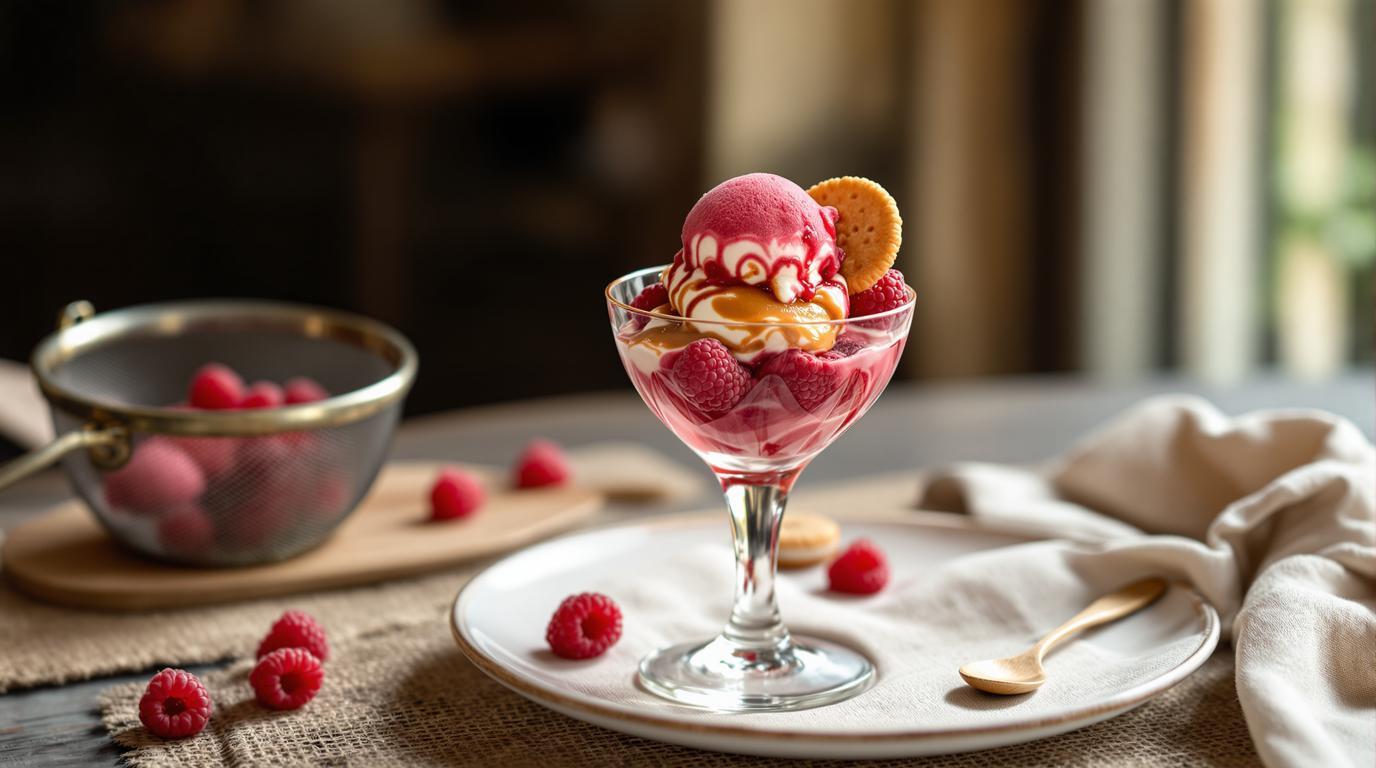The journey to perfect sorbet began during my stint at a small bistro in Provence. Working alongside an 80-year-old French grandmother, I watched in awe as she transformed raspberries into something magical—without fancy equipment or additives. “Jordan,” she whispered, squeezing lemon over crushed berries, “le secret est dans la patience.” That patience transformed into the most intensely flavored sorbet I’d ever tasted: bright crimson jewels melting on the tongue, capturing summer’s essence with each spoonful. Today, I’m sharing my adaptation of her time-honored technique that balances tartness with just enough sweetness to let those raspberries sing.
The Story
Traditional raspberry sorbet—or Sorbet Framboise—exists at the intersection of simplicity and sophistication. While modernized versions often incorporate stabilizers or egg whites, grandmother-style sorbet relies on perfectly balanced ingredients and careful technique. This recipe honors that tradition while making it accessible to home cooks. What makes this approach special is the deliberate straining process that removes seeds while preserving the intense raspberry flavor and brilliant color that commercial versions rarely capture.
Ingredients Spotlight
The beauty of this recipe lies in its simplicity:
- 2 pounds (900g) fresh raspberries—their natural pectin helps with texture
- 1½ cups (300g) granulated sugar—creates both sweetness and proper freezing point
- 1 cup (240ml) water—for creating a proper simple syrup
- 1-2 tablespoons fresh lemon juice—brightens flavors and preserves color
- 1 teaspoon vanilla extract (optional)—adds subtle aromatic complexity
The ratio of sugar to fruit is crucial—too little creates ice crystals, while too much prevents proper freezing. This balance took me years to perfect, but grandmother’s intuition nailed it immediately.
Step-by-Step Guide
1. Create a simple syrup by combining sugar and water in a saucepan over medium heat, stirring until completely dissolved (about 5 minutes). Cool completely.
2. Pulse raspberries in a food processor until smooth but not over-processed—we want to preserve some texture.
3. Press raspberry purée through a fine-mesh sieve, using a spatula with gentle pressure. This removes seeds while capturing the essence of the fruit. This step requires patience—rush it and you’ll sacrifice flavor.
4. Combine strained purée with cooled simple syrup, lemon juice, and vanilla (if using). Taste and adjust—remember that freezing dulls sweetness, so it should taste slightly sweeter than you’d prefer.
5. Refrigerate mixture for at least 1 hour to ensure it’s thoroughly chilled.
6. Churn in an ice cream maker according to manufacturer’s instructions until it reaches soft-serve consistency (about 20-30 minutes).
7. Transfer to a freezer-safe container and freeze for 2-3 hours before serving.
Expert Techniques
The difference between good and extraordinary sorbet lies in technique. When straining, don’t press too hard—gentle pressure extracts flavor without bitter compounds from the seeds. If you don’t have an ice cream maker, freeze the mixture in a shallow dish, vigorously stirring every 30 minutes to break up ice crystals until evenly frozen.
Chef’s Note: When tasting your base, remember this principle: a properly sweetened sorbet base should taste slightly too sweet at room temperature. Once frozen, the perception of sweetness diminishes dramatically. Trust this counterintuitive technique—it’s the difference between professionally balanced sorbet and an icy, tart disappointment.
For a silkier texture, add a tablespoon of vodka or raspberry liqueur after churning—it won’t freeze completely, preventing those unwanted ice crystals. This is especially helpful for those making this without professional equipment.
Presentation & Pairing Ideas
Serve this vibrant sorbet in chilled bowls with fresh raspberries and perhaps a delicate butter cookie for textural contrast. For a sophisticated dessert, try it alongside my 60-Second Chocolate Mug Cake or as a refreshing intermezzo between courses of a heavier meal like traditional cassoulet.
For a show-stopping dessert, layer it with Caramel Swirl Ice Cream in glass coupes. The temperature contrast between room-temperature berries and frozen sorbet creates a delightful sensory experience that elevates this humble dessert.
Don’t be afraid to make this recipe your own. The grandmother who taught me would often add a pinch of dried lavender to her sorbet when serving it to special guests—a simple twist that transformed a familiar dessert into something memorable. Your kitchen, your rules—respect tradition, but find your signature. That’s the true spirit of cooking with heart. 🍧
